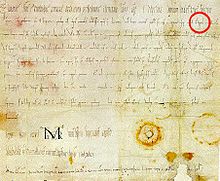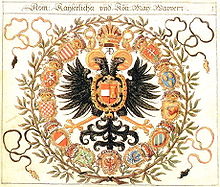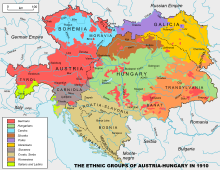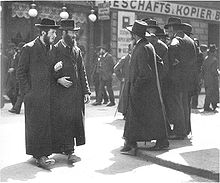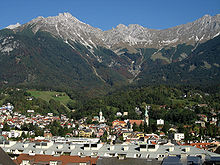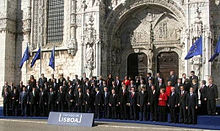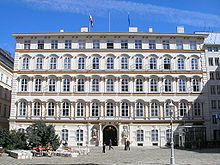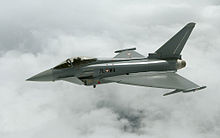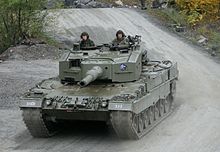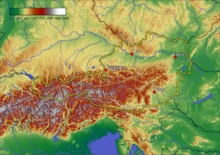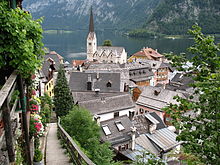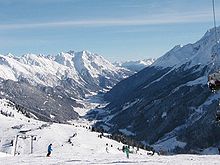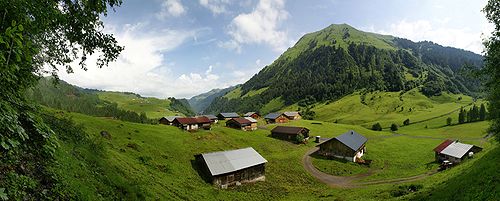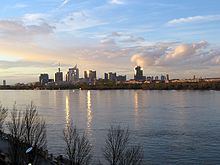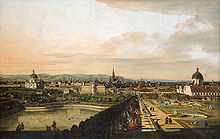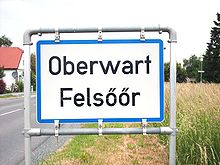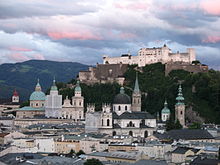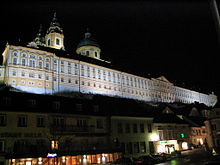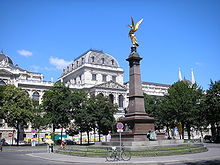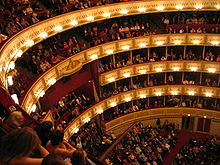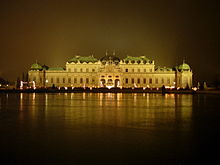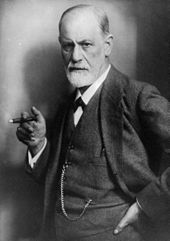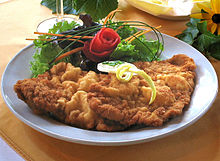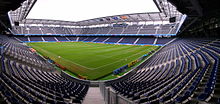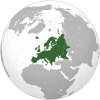- Austria
-
This article is about the country. For other uses, see Austria (disambiguation)."Österreich" and "Oesterreich" redirect here. For the surname rendered in either of these two ways, see Österreich (surname). For the Austrian national anthem, whose melody is often given the short-form name "Österreich" or "Oesterreich", see Land der Berge, Land am Strome.
Republic of Austria
Republik Österreich

Flag Coat of arms Anthem: Land der Berge, Land am Strome (German)
Land of Mountains, Land by the River
Location of Austria (dark green)– in Europe (green & dark grey)
– in the European Union (green) — [Legend]Capital
(and largest city)Vienna
48°12′N 16°21′E / 48.2°N 16.35°EOfficial language(s) German Spoken languages Austro-Bavarian, Alemannic in Vorarlberg. Locally also Slovene, Burgenland Croatian and Hungarian Ethnic groups (2001) 91.1% Austrians,
8.9% foreigners -
4% former Yugoslavs,
1.6% Turks,
2.4% others and unspecified[1]Demonym Austrian Government Federal Parliamentary republic - President Heinz Fischer - Chancellor Werner Faymann (SPÖ) - President of the National Council Barbara Prammer (SPÖ) Independence - Austrian State Treaty in force 27 July 1955 (Duchy: 1156, Austrian Empire: 1804, First Austrian Republic: 1918–1938, Second Republic since 1945) Area - Total 83,855 km2 (115th)
32,377 sq mi- Water (%) 1.7 Population - 2011 estimate 8,414,638[2] (92nd) - 2001 census 8,032,926 - Density 99/km2 (99th)
257/sq miGDP (PPP) 2011 estimate - Total $343 billion[3] - Per capita $40.979[3] GDP (nominal) 2011 estimate - Total $405 billion[3] - Per capita $48,350[3] Gini (2007) 26[4] (low) HDI (2011)  0.885[5] (very high) (19th)
0.885[5] (very high) (19th)Currency Euro (€) ² ( EUR)Time zone CET (UTC+01) - Summer (DST) CEST (UTC+02) Drives on the right ISO 3166 code AT Internet TLD .at ³ Calling code 43 1 Slovene, Croatian, Hungarian are officially recognised regional languages and Austrian Sign Language is a protected minority language throughout the country. 2 Euro since 1 Jan 1999 virtual, since 1 Jan 2002 real currency; before: Austrian Schilling. 3 The .eu domain is also used, as it is shared with other European Union member states. Austria (
 i/ˈɒstriə/ or /ˈɔːstriə/; German: Österreich [ˈøːstɐˌʁaɪç] (
i/ˈɒstriə/ or /ˈɔːstriə/; German: Österreich [ˈøːstɐˌʁaɪç] ( listen)), officially the Republic of Austria (German: Republik Österreich), is a landlocked country of roughly 8.4 million people[2] in Central Europe. It is bordered by the Czech Republic and Germany to the north, Slovakia and Hungary to the east, Slovenia and Italy to the south, and Switzerland and Liechtenstein to the west. The territory of Austria covers 83,855 square kilometres (32,377 sq mi) and has a temperate and alpine climate. Austria's terrain is highly mountainous due to the presence of the Alps; only 32% of the country is below 500 metres (1,640 ft), and its highest point is 3,798 metres (12,461 ft).[6] The majority of the population speak local Austro-Bavarian dialects of German as their native language,[7] and German in its standard form is the country's official language.[8] Other local official languages are Burgenland Croatian, Hungarian and Slovene.[6]
listen)), officially the Republic of Austria (German: Republik Österreich), is a landlocked country of roughly 8.4 million people[2] in Central Europe. It is bordered by the Czech Republic and Germany to the north, Slovakia and Hungary to the east, Slovenia and Italy to the south, and Switzerland and Liechtenstein to the west. The territory of Austria covers 83,855 square kilometres (32,377 sq mi) and has a temperate and alpine climate. Austria's terrain is highly mountainous due to the presence of the Alps; only 32% of the country is below 500 metres (1,640 ft), and its highest point is 3,798 metres (12,461 ft).[6] The majority of the population speak local Austro-Bavarian dialects of German as their native language,[7] and German in its standard form is the country's official language.[8] Other local official languages are Burgenland Croatian, Hungarian and Slovene.[6]The origins of modern-day Austria date back to the time of the Habsburg dynasty when the vast majority of the country was a part of the Holy Roman Empire of the German Nation. During the 17th and 18th centuries, Austria became one of the great powers of Europe and, in response to the coronation of Napoleon I as the Emperor of the French, the Austrian Empire was officially proclaimed in 1804. In 1867, the Austrian Empire was reformed into Austria-Hungary.
When the Habsburg (Austro-Hungarian) Empire collapsed in 1918 with the end of World War I, Austria used German Austria („Deutschösterreich”, later „Österreich”) as the state name in an attempt for union with Germany but was forbidden due to the Treaty of Saint Germain. The First Austrian Republic was established in 1919. In the 1938 Anschluss, Austria was occupied and annexed by Nazi Germany.[9] This lasted until the end of World War II in 1945, after which Nazi Germany was occupied by the Allies and Austria's former democratic constitution was restored. In 1955, the Austrian State Treaty re-established Austria as a sovereign state, ending the occupation. In the same year, the Austrian Parliament created the Declaration of Neutrality which declared that the Second Austrian Republic would become permanently neutral.
Today, Austria is a parliamentary representative democracy comprising nine federal states.[6][10] The capital and largest city, with a population exceeding 1.6 million, is Vienna.[6][11] Austria is one of the richest countries in the world, with a nominal per capita GDP of $48,350 (2011 est.). The country has developed a high standard of living and in 2011 was ranked 19th in the world for its Human Development Index. Austria has been a member of the United Nations since 1955,[12] joined the European Union in 1995,[6] and is a founder of the OECD.[13] Austria also signed the Schengen Agreement in 1995,[14] and adopted the European currency, the Euro, in 1999.
Contents
Etymology
Main article: Name of AustriaThe German name for Austria, Österreich, derives from the word Ostarrîchi, which first appears in the "Ostarrîchi document" of 996.[15] This word is probably a translation of Medieval Latin Marchia orientalis into a local (Bavarian) dialect. The name means "Eastern borderlands". It was a prefecture of Bavaria created in 976. The word "Austria" is a Latinisation of the German name and was first recorded in the 12th century.
Friedrich Heer, one of the most important Austrian historians in the 20th century, stated in his book Der Kampf um die österreichische Identität (The Struggle Over Austrian Identity),[16] that the Germanic form Ostarrîchi was not a translation of the Latin word, but both resulted from a much older term originating in the Celtic languages of ancient Austria: more than 2,500 years ago, the major part of the actual country was called Norig by the Celtic population (Hallstatt culture); according to Heer, no- or nor- meant "east" or "eastern", whereas -rig is related to the modern German Reich, meaning "realm". Accordingly, Norig would essentially mean Ostarrîchi and Österreich, thus Austria. The Celtic name was eventually Latinised to Noricum after the Romans conquered the area that encloses most of modern day Austria, in approximately 15 BC. Noricum later became a Roman province in the mid 1st century AD.[17]
History
Main article: History of AustriaSettled in ancient times,[10] the Central European land that is now Austria was occupied in pre-Roman times by various Celtic tribes. The Celtic kingdom of Noricum was later claimed by the Roman Empire and made a province. Present day Petronell-Carnuntum in Eastern Austria was an important army camp turned capital city in what became known as the Upper Pannonia province. Fifty thousand people called Carnuntum home for nearly 400 years.[18]
Coats of arms of the Habsburg Emperor in 1605
After the fall of the Roman Empire the area was invaded by Bavarians, Slavs and Avars.[19] The Slavic tribe of the Carantanians migrated into the Alps and established the realm of Carantania, which covered much of eastern and central Austrian territory. Charlemagne conquered the area in 788 AD, encouraged colonisation and introduced Christianity.[19] As part of Eastern Francia, the core areas that now encompass Austria were bequeathed to the house of Babenberg. The area was known as the marchia Orientalis and was given to Leopold of Babenberg in 976.[20]
The first record showing the name Austria is from 996 where it is written as Ostarrîchi, referring to the territory of the Babenberg March.[20] In 1156 the Privilegium Minus elevated Austria to the status of a duchy. In 1192, the Babenbergs also acquired the Duchy of Styria. With the death of Frederick II in 1246, the line of the Babenbergs went extinct.[21]
As a result Ottokar II of Bohemia effectively assumed control of the duchies of Austria, Styria and Carinthia.[21] His reign came to an end with his defeat at Dürnkrut at the hands of Rudolph I of Germany in 1278.[22] Thereafter, until World War I, Austria's history was largely that of its ruling dynasty, the Habsburgs.
In the 14th and 15th centuries, the Habsburgs began to accumulate other provinces in the vicinity of the Duchy of Austria. In 1438 Duke Albert V of Austria was chosen as the successor to his father-in-law, Emperor Sigismund. Although Albert himself only reigned for a year, henceforth every emperor of the Holy Roman Empire was a Habsburg, with only one exception.
The Habsburgs began also to accumulate lands far from the hereditary lands. In 1477 Archduke Maximilian, only son of Emperor Frederick III, married the heiress Maria of Burgundy, thus acquiring most of the Netherlands for the family.[23][24] His son Philip the Fair married the heiress of Castile and Aragon, and thus acquired Spain and its Italian, African and New World appendages for the Habsburgs.[23][24] In 1526 following the Battle of Mohács, Bohemia and the part of Hungary not occupied by the Ottomans came under Austrian rule.[25] Ottoman expansion into Hungary led to frequent conflicts between the two empires, particularly evident in the so-called Long War of 1593 to 1606. The Turks made incursions into Styria nearly twenty times;[26] burning, pillaging, and taking thousands of slaves.[27]
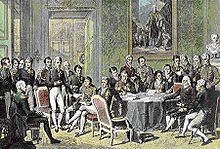 The Congress of Vienna by Jean-Baptiste Isabey, 1819
The Congress of Vienna by Jean-Baptiste Isabey, 1819
During the long reign of Leopold I (1657–1705) and following the successful defense of Vienna in 1683 (under the command of the King of Poland, John III Sobieski),[28] a series of campaigns resulted in bringing all of Hungary to Austrian control by the Treaty of Karlowitz in 1699.
Emperor Charles VI relinquished many of the fairly impressive gains the empire made in the previous years, largely due to his apprehensions at the imminent extinction of the House of Habsburg. Charles was willing to offer concrete advantages in territory and authority in exchange for other powers' worthless recognitions of the Pragmatic Sanction that made his daughter Maria Theresa his heir. With the rise of Prussia the Austrian–Prussian dualism began in Germany. Austria participated, together with Prussia and Russia, in the first and the third of the three Partitions of Poland (in 1772 and 1795).
Austria later became engaged in a war with Revolutionary France, at the beginning highly unsuccessful, with successive defeats at the hands of Napoleon meaning the end of the old Holy Roman Empire in 1806. Two years earlier,[29] in 1804, the Empire of Austria was founded. In 1814 Austria was part of the Allied forces that invaded France and brought to an end the Napoleonic Wars.
It thus emerged from the Congress of Vienna in 1815 as one of four of the continent's dominant powers and a recognised great power. The same year, the German Confederation, (Deutscher Bund) was founded under the presidency of Austria. Because of unsolved social, political and national conflicts the German lands were shaken by the 1848 revolution aiming to create a unified Germany.[30] A unified Germany would have been possible either as a Greater Germany, or a Greater Austria or just the German Confederation without Austria at all. As Austria was not willing to relinquish its German-speaking territories to what would become the German Empire of 1848, the crown of the newly formed empire was offered to the Prussian King Friedrich Wilhelm IV. In 1864, Austria and Prussia fought together against Denmark and successfully freed the independent duchies of Schleswig and Holstein. Nevertheless as they could not agree on a solution to the administration of the two duchies, they fought in 1866 the Austro-Prussian War. Defeated by Prussia in the Battle of Königgrätz,[30] Austria had to leave the German Confederation and subsequently no longer took part in German politics.[31][32]
The Austro-Hungarian Compromise of 1867, the Ausgleich, provided for a dual sovereignty, the Austrian Empire and the Kingdom of Hungary, under Franz Joseph I.[33] The Austrian-Hungarian rule of this diverse empire included various Slavic groups including Croats, Czechs, Poles, Rusyns, Serbs, Slovaks, Slovenes and Ukrainians, as well as large Italian and Romanian communities.
As a result, ruling Austria–Hungary became increasingly difficult in an age of emerging nationalist movements, causing a high reliance on the use of an expanded secret police. Yet the government of Austria tried its best to be accommodating in some respects: The Reichsgesetzblatt, publishing the laws and ordinances of Cisleithania, was issued in eight languages, all national groups were entitled to schools in their own language and to the use of their mother tongue at state offices, for example. The government of Hungary to the contrary tried to magyarise few ethnic entities[which?]. Thus the wishes of ethnic groups dwelling in both parts of the dual monarchy hardly could be solved.
20th century
The assassination of Archduke Franz Ferdinand in Sarajevo in 1914 by Bosnian Serb Gavrilo Princip[34]) was used by leading Austrian politicians and generals to persuade the emperor to declare war on Serbia, thereby risking and prompting the outbreak of World War I which led to the dissolution of the Austro-Hungarian Empire. Over one million Austro-Hungarian soldiers died in World War I.[35]
On 21 October 1918, the elected German members of the Reichsrat (parliament of Imperial Austria) met in Vienna as the Provisional National Assembly for German Austria (Provisorische Nationalversammlung für Deutschösterreich). On 30 October the assembly founded the State of German Austria by appointing a government, called Staatsrat. This new government was invited by the emperor to take part in the decision on the planned armistice with Italy, but refrained from this business; this left the responsibility for the end of the war on 3 November 1918, solely to the emperor and his government. On 11 November the emperor, counseled by ministers of the old and the new government, declared he would not take part in state business any more; on 12 November German Austria, by law, declared itself to be a democratic republic and part of the new German republic. The constitution, renaming Staatsrat to Bundesregierung (federal government) and Nationalversammlung to Nationalrat (national council) was passed on 10 November 1920.
The Treaty of Saint-Germain of 1919 (for Hungary the Treaty of Trianon of 1920) confirmed and consolidated the new order of Central Europe which to a great part had been established in November 1918, creating new states and resizing others. Over 3-million German speaking Austrians found themselves living outside of the newborn Austrian Republic as minorities in the newly formed or enlarged respective states of Czechoslovakia, Yugoslavia, Hungary and Italy.[36] This included the provinces of South Tyrol and German Bohemia, the latter of which would play a role in sparking WWII. The South Tyrol question would become a lingering problem between Austria and Italy until it was officially settled by the 1980s with a large degree of autonomy being granted by the Italian national government. Between 1918 and 1919 Austria was known as the State of German Austria (Staat Deutschösterreich). Not only did the Entente powers forbid German Austria to unite with Germany, they also rejected the name German Austria in the peace treaty to be signed; it was therefore changed to Republic of Austria in late 1919.[37]
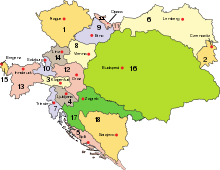 Map of Austria–Hungary
Map of Austria–Hungary
After the war inflation began to devaluate the Krone, still Austria's currency. In the autumn of 1922 Austria was granted an international loan supervised by the League of Nations.[38] The purpose of the loan was to avert bankruptcy, stabilise the currency and improve its general economic condition. With the granting of the loan, Austria passed from an independent state to the control exercised by the League of Nations. In 1925 the Schilling, replacing the Krone by 10,000:1, was introduced. Later it was called the Alpine dollar due to its stability. From 1925 to 1929 the economy enjoyed a short high before nearly crashing after Black Friday.
The First Austrian Republic lasted until 1933 when Chancellor Engelbert Dollfuss, using what he called "self-switch-off of Parliament" (Selbstausschaltung des Parlaments), established an autocratic regime tending toward Italian fascism.[39][40] The two big parties at this time, the Social Democrats and the Conservatives, had paramilitary armies;[41] the Social Democrats' Schutzbund was now declared illegal but still operative[41] as civil war broke out.[39][40][42]
Orthodox Jews in Leopoldstadt. About 10% of the total population of Vienna were Jews.
In February 1934 several members of the Schutzbund were executed,[43] the Social Democratic party was outlawed and many of its members were imprisoned or emigrated.[42] On 1 May 1934, the Austrofascists imposed a new constitution ("Maiverfassung") which cemented Dollfuss's power but on 25 July he was assassinated in a Nazi coup attempt.[44][45]
His successor, Kurt Schuschnigg, struggled to keep Austria independent as "the better German state", but on 12 March 1938, German troops occupied the country[46] while Austrian Nazis took over government. On 13 March 1938, the Anschluss of Austria was officially declared. Two days later Hitler, a native of Austria himself, did what he called the "re-unification" of his home country with the rest of Germany on Vienna's Heldenplatz. He established a plebiscite confirming the union with Germany in April 1938.
Austria was incorporated into the Third Reich and ceased to exist as an independent state. The Aryanisation of the wealth of Jewish Austrians started immediately mid-March with a so called "wild" (i.e. extra-legal) phase but soon was structured legally and bureaucratically to strip Jewish citizens of any asset they may have possessed. The Nazis called Austria "Ostmark"[46] until 1942 when it was again renamed and called "Alpen-Donau-Reichsgaue". Some of the most prominent Nazis were of Austrian origin, including Adolf Hitler, Ernst Kaltenbrunner, Adolf Eichmann, Franz Stangl, and Odilo Globocnik,[47] as were 40% of the staff at Nazi extermination camps.[48] Vienna fell on 13 April 1945, during the Soviet Vienna Offensive just before the total collapse of the Third Reich. The invading Allied powers, in particular the Americans, planned for the supposed "Alpine Fortress Operation" of national redoubt that was largely to have taken place on Austrian soil in the mountains of the eastern Alps. However it never materialized because of the rapid collapse of the Reich.
Karl Renner and Adolf Schärf (Socialist Party of Austria [Social Democrats and Revolutionary Socialists]), Leopold Kunschak (Austria's People's Party [former Christian Social People's Party]) and Johann Koplenig (Communist Party of Austria) declared Austria's secession from the Third Reich by the Declaration of Independence on 27 April 1945 and set up a provisional government in Vienna under state Chancellor Renner the same day, with the approval of the victorious Red Army and backed by Joseph Stalin.[49] (The date is officially named the birthday of the second republic.) At the end of April, most of Western and Southern Austria still was under Nazi rule. On 1 May 1945, the federal constitution of 1929, which had been terminated by dictator Dollfuss on 1 May 1934, was declared valid again.
Innsbruck hosted the 1964 and 1976 Winter Olympics and will host the 2012 Winter Youth Olympics, the first in history
Total military deaths from 1939–1945 are estimated at 260,000.[50] Jewish Holocaust victims totaled 65,000.[51] About 140,000 Jewish Austrians had fled the country in 1938–39. Thousands of Austrians had taken part in serious Nazi crimes, a fact officially recognised by Chancellor Franz Vranitzky in 1992.
Much like Germany, Austria was divided into British, French, Soviet and American zones and governed by the Allied Commission for Austria.[52] As forecast in the Moscow Declaration in 1943, there was a subtle difference in the treatment of Austria by the Allies.[49] The Austrian Government, consisting of Social Democrats, Conservatives and Communists (until 1947) and residing in Vienna, which was surrounded by the Soviet zone, was recognised by the Western Allies in October 1945 after some doubts that Renner could be Stalin's puppet. Thereby the creation of a separate Western Austrian government and the division of the country could be avoided. Austria, in general, was treated as though it had been originally invaded by Germany and liberated by the Allies.[53]
On 15 May 1955, after talks which lasted for years and were influenced by the Cold War, Austria regained full independence by concluding the Austrian State Treaty with the Four Occupying Powers. On 26 October 1955, after all occupation troops had left, Austria declared its "permanent neutrality" by an act of parliament, which remains to this day but has been implicitly overlapped by constitutional amendments concerning Austria as member of the European Union from 1995 onwards.[54]
The political system of the Second Republic is based on the constitution of 1920 and 1929, which was reintroduced in 1945. The system came to be characterised by Proporz, meaning that most posts of political importance were split evenly between members of the Social Democrats and the People's Party.[55] Interest group "chambers" with mandatory membership (e.g. for workers, business people, farmers) grew to considerable importance and were usually consulted in the legislative process, so that hardly any legislation was passed that did not reflect widespread consensus.[56] Since 1945 a single-party government took place only 1966–1970 (Conservatives) and 1970–1983 (Social Democrats). During all other legislative periods, either a grand coalition of Conservatives and Social Democrats or a "small coalition" (one of these two and a smaller party) ruled the country.
Following a referendum in 1994, at which consent reached a majority of two thirds, the country became a member of the European Union on 1 January 1995.[57]
The major parties SPÖ and ÖVP have contrary opinions about the future status of Austria's military non-alignment:[citation needed] While the SPÖ in public supports a neutral role, the ÖVP argues for stronger integration into the EU's security policy; even a future NATO membership is not ruled out by some ÖVP politicians[who?]. In reality, Austria is taking part in the EU's Common Foreign and Security Policy, participates in the so-called[by whom?] Petersburg Agenda (including peace keeping and peace creating tasks) and has become member of NATO's "Partnership for Peace"; the constitution has been amended accordingly. Since 2008, due to the Schengen Agreement, the only neighbouring country performing border controls towards Austria is Liechtenstein.
Politics
Main article: Politics of Austria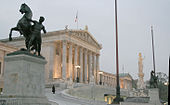 Austrian Parliament in Vienna
Austrian Parliament in Vienna
The Parliament of Austria is located in Vienna, the country's largest city and capital. Austria became a federal, parliamentary, democratic republic through the Federal Constitution of 1920. The political system of the Second Republic with its nine states is based on the constitution of 1920 and 1929, which was reenacted on 1 May 1945.[58] The head of state is the Federal President (Bundespräsident), who is directly elected by popular vote. The chairman of the Federal Government is the Federal Chancellor, who is appointed by the president. The government can be removed from office by either a presidential decree or by vote of no confidence in the lower chamber of parliament, the Nationalrat. Voting for the federal president and for the Parliament used to be compulsory in Austria, but this was abolished in steps from 1982 to 2004.[59]
The Parliament of Austria consists of two chambers. The composition of the Nationalrat (183 seats) is determined every five years (or whenever the Nationalrat has been dissolved by the federal president on a motion by the federal chancellor, or by Nationalrat itself) by a general election in which every citizen over 16 years (since 2007) has voting rights. While there is a general threshold of 4 percent for all parties at federal elections (Nationalratswahlen), there remains the possibility to gain a direct seat, or Direktmandat, in one of the 43 regional election districts.
The Nationalrat is the dominant chamber in the formation of legislation in Austria. However, the upper house of parliament, the Bundesrat, has a limited right of veto (the Nationalrat can—in almost all cases—ultimately pass the respective bill by voting a second time. This is referred to as 'Beharrungsbeschluss, lit. "vote of persistence"). A convention, called the Österreich -Konvent[60] was convened on 30 June 2003 to decide upon suggestions to reform the constitution, but failed to produce a proposal that would receive the two-thirds of votes in the Nationalrat necessary for constitutional amendments and/or reform.
With legislative and executive, the courts are the third column of Austrian state powers. Notably the Constitutional Court (Verfassungsgerichtshof) may exert considerable influence on the political system by ruling out laws and ordinances not in compliance with the constitution. Since 1995, the European Court of Justice may overrule Austrian decisions in all matters defined in laws of the European Union. Austria also implements the decisions of the European Court of Human Rights, since the European Convention on Human Rights is part of the Austrian constitution.
Recent developments
After general elections held in October 2006, the Social Democrats emerged as the largest party, whereas the People's Party lost about 8% in votes.[61][62] Political realities prohibited any of the two major parties from forming a coalition with smaller parties. In January 2007 the People's Party and Social Democrats formed a grand coalition with the social democrat Alfred Gusenbauer as Chancellor. This coalition broke up in June 2008. Elections in September 2008 further weakened both major parties (Social Democrats and People's Party) but together they still held more than 50% of the votes with the Social Democrats holding the majority. They formed a coalition with Werner Faymann from the Social Democrats as Chancellor. The positions of the Freedom Party and the deceased Jörg Haider's new party Alliance for the Future of Austria, both parties on the political right, were strengthened during the election.
Foreign relations
Main article: Foreign relations of AustriaThe 1955 Austrian State Treaty ended the occupation of Austria following World War II and recognised Austria as an independent and sovereign state. On 26 October 1955, the Federal Assembly passed a constitutional article in which "Austria declares of her own free will her perpetual neutrality". The second section of this law stated that "in all future times Austria will not join any military alliances and will not permit the establishment of any foreign military bases on her territory". Since then, Austria has shaped its foreign policy on the basis of neutrality, but rather different from the neutrality of Switzerland.
Austria began to reassess its definition of neutrality following the fall of the Soviet Union, granting overflight rights for the UN-sanctioned action against Iraq in 1991, and, since 1995, it has developed participation in the EU's Common Foreign and Security Policy (CFSP). Also in 1995, it joined the Partnership for Peace and subsequently participated in peacekeeping missions in Bosnia. Meanwhile, the only part of the Constitutional Law on Neutrality of 1955 still valid fully is not to allow foreign military bases in Austria.[citation needed]
Austria attaches great importance to participation in the Organisation for Economic Co-operation and Development and other international economic organisations, and it has played an active role in the Organization for Security and Cooperation in Europe (OSCE). As an OSCE participating State, Austria’s international commitments are subject to monitoring under the mandate of the U.S. Helsinki Commission.
Military
Main article: Austrian Armed ForcesThe manpower of the Austrian Armed Forces (German: Bundesheer) mainly relies on conscription. All males who have reached the age of eighteen and are found fit have to serve a six months military service, followed by an eight year reserve obligation. Both males and females at the age of sixteen are eligible for voluntary service.[6] Conscientious objection is legally acceptable and those who claim this right are obliged to serve an institutionalised nine months civilian service instead. Since 1998, women volunteers have been allowed to become professional soldiers.
The main sectors of the Bundesheer are Joint Forces (Streitkräfteführungskommando, SKFüKdo) which consist of Land Forces (Landstreitkräfte), Air Forces (Luftstreitkräfte), International Missions (Internationale Einsätze) and Special Forces (Spezialeinsatzkräfte), next to Mission Support (Kommando Einsatzunterstützung; KdoEU) and Command Support (Kommando Führungsunterstützung; KdoFüU). Austria is a landlocked country and has no navy.
In 2004, Austria's defence expenditures corresponded to approximately 0.9% of its GDP. The Army currently has about 45,000 soldiers, of whom about half are conscripts. As head of state, Austrian President (currently Heinz Fischer) is nominally the Commander-in-Chief of the Bundesheer. In practical reality, however, command of the Austrian Armed Forces is almost exclusively exercised by the Minister of Defense, currently Norbert Darabos.
Since the end of the Cold War, and more importantly the removal of the former heavily guarded "Iron Curtain" separating Austria and Hungary, the Austrian military has been assisting Austrian border guards in trying to prevent border crossings by illegal immigrants. This assistance came to an end when Hungary joined the EU Schengen Area in 2008, for all intents and purposes abolishing "internal" border controls between treaty states. Some politicians have called for a prolongation of this mission, but the legality of this is heavily disputed. In accordance with the Austrian constitution, armed forces may only be deployed in a limited number of cases, mainly to defend the country and aid in cases of national emergency, such as in the wake of natural disasters. They may generally not be used as auxiliary police forces.
Within its self-declared status of permanent neutrality, Austria has a long and proud tradition of engaging in UN-led peacekeeping and other humanitarian missions. The Austrian Forces Disaster Relief Unit (AFDRU), in particular, an all-volunteer unit with close ties to civilian specialists (e.g. rescue dog handlers) enjoys a reputation as a quick (standard deployment time is 10 hours) and efficient SAR unit. Currently, larger contingents of Austrian forces are deployed in Bosnia, Kosovo and, since 1974, in the Golan Heights.
Administrative divisions
Main article: States of AustriaAs a federal republic, Austria is divided into nine states (German: Bundesländer).[6] These states are then divided into districts (Bezirke) and statutory cities (Statutarstädte). Districts are subdivided into municipalities (Gemeinden). Statutory Cities have the competencies otherwise granted to both districts and municipalities. The states are not mere administrative divisions but have some legislative authority distinct from the federal government, e.g. in matters of culture, social care, youth and nature protection, hunting, building, and zoning ordinances. In recent years, it has been discussed whether today it is appropriate for a small country to maintain ten parliaments.
State (Bundesland) Capital Area Population [63] Rank 
1 Burgenland Eisenstadt 3,966 km² 280,350 9 2 Carinthia (Kärnten) Klagenfurt 9,536 km² 560,753 6 3 Lower Austria (Niederösterreich) St. Pölten 19,174 km² 1,588,545 2 4 Upper Austria (Oberösterreich) Linz 11,980 km² 1,405,986 3 5 Salzburg Salzburg 7,154 km² 529,085 7 6 Styria (Steiermark) Graz 16,392 km² 1,203,986 4 7 Tyrol (Tirol) Innsbruck 12,648 km² 698,472 5 8 Vorarlberg Bregenz 2,601 km² 364,611 8 9 Vienna (Wien) Vienna (Wien) 414.90 km² 1,660,534 1 Geography
Main article: Geography of AustriaView of Hallstatt
Austria is a largely mountainous country due to its location in the Alps.[64] The Central Eastern Alps, Northern Limestone Alps and Southern Limestone Alps are all partly in Austria. Of the total area of Austria (84,000 km2 or 32,433 sq mi), only about a quarter can be considered low lying, and only 32% of the country is below 500 metres (1,640 ft). The Alps of western Austria give way somewhat into low lands and plains in the eastern part of the country.
Austria lies between latitudes 46° and 49° N, and longitudes 9° and 18° E.
It can be divided into five areas, the biggest being the Eastern Alps, which constitute 62% of nation's total area. The Austrian foothills at the base of the Alps and the Carpathians account for around 12% and the foothills in the east and areas surrounding the periphery of the Pannoni low country amount to about 12% of the total landmass. The second greater mountain area (much lower than the Alps) is situated in the north. Known as the Austrian granite plateau, it is located in the central area of the Bohemian Mass and accounts for 10% of Austria. The Austrian portion of the Vienna basin comprises the remaining 4%.
The six highest mountains in Austria are:
Name Height (m) Height (ft) Range Großglockner 3,797 12,457 Hohe Tauern Wildspitze 3,768 12,362 Ötztal Alps Weißkugel 3,739 12,267 Ötztal Alps Großvenediger 3,674 12,054 Hohe Tauern Similaun 3,606 11,831 Ötztal Alps Großes Wiesbachhorn 3,571 11,715 Hohe Tauern Phytogeographically, Austria belongs to the Central European province of the Circumboreal Region within the Boreal Kingdom. According to the WWF, the territory of Austria can be subdivided into four ecoregions: the Central European mixed forests, Pannonian mixed forests, Alps conifer and mixed forests and Western European broadleaf forests.
Climate
The greater part of Austria lies in the cool/temperate climate zone in which humid westerly winds predominate. With over half of the country dominated by the Alps, the alpine climate is the predominant one. In the east—in the Pannonian Plain and along the Danube valley—the climate shows continental features with less rain than the alpine areas. Although Austria is cold in the winter (−10 – 0 °C), summer temperatures can be relatively warm,[65] with average temperatures in the mid-20s and a highest temperature of 39.7 °C (103.5 °F).[66]
Austrian rural area of Schoppernau in summer.
Economy
Main article: Economy of AustriaSee also: List of Austrian companiesAustria is the 12th richest country in the world in terms of GDP (Gross domestic product) per capita,[3] has a well-developed social market economy, and a high standard of living. Until the 1980s, many of Austria's largest industry firms were nationalised; in recent years, however, privatisation has reduced state holdings to a level comparable to other European economies. Labour movements are particularly strong in Austria and have large influence on labour politics. Next to a highly developed industry, international tourism is the most important part of the national economy.
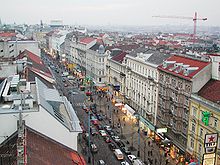 Mariahilf shopping avenue
Mariahilf shopping avenue
Germany has historically been the main trading partner of Austria, making it vulnerable to rapid changes in the German economy. However, since Austria became a member state of the European Union it has gained closer ties to other European Union economies, reducing its economic dependence on Germany. In addition, membership in the EU has drawn an influx of foreign investors attracted by Austria's access to the single European market and proximity to the aspiring economies of the European Union. Growth in GDP accelerated in recent years and reached 3.3% in 2006.[67] Austria indicated on 16 Nov 2010 that it would withhold the December installment of its contribution to the EU bailout of Greece citing material worsening of the Greek debt situation and apparent inability of Greece to collect the level of tax receipts it had previously promised.[68]
Since the fall of communism, Austrian companies have been quite active players and consolidators in Eastern Europe. Between 1995 and 2010, 4'868 mergers & acquisitions with a total known value of 163 bil. EUR with the involvement of Austrian firms have been announced.[69] The largest transactions with involvement of Austrian companies[70] have been: the acquisition of Bank Austria by Bayerische Hypo- und Vereinsbank for 7.8 bil. EUR in 2000, the acquisition of Porsche Holding Salzburg by Volkswagen Group for 3.6 bil. EUR in 2009,[71] and the acquisition of Banca Comercială Română by Erste Group for 3.7 bil. EUR in 2005.[72]
Currency
Main article: Austrian euro coinsIn Austria, the euro was introduced as an accounting currency on 1 January 1999, and euro coins and banknotes entered circulation on 1 January 2002. As a preparation for this date, the minting of the new euro coins started as early as 1999, however all Austrian euro coins introduced in 2002 have this year on it; unlike other countries of the Eurozone where mint year is minted in the coin. Eight different designs, one per face value, were selected for the Austrian coins. In 2007, to adopt the new common map like the rest of the Eurozone countries, Austria changed the common side of its coins.
Before adopting the Euro in 2002 Austria had maintained use of the Austrian schilling which was first established in December 1924. The Schilling was abolished in the wake of the Anschluss in 1938 and was reintroduced after the end of the World War II in November 1945.
Austria has one of the richest collection of collectors' coins in the Eurozone, with face value ranging from 10 to 100 euro (although a 100,000 euro coin was exceptionally minted in 2004). These coins are a legacy of an old national practice of the minting of silver and gold coins. Unlike normal issues, these coins are not legal tender in all the eurozone. For instance, a €5 Austrian commemorative coin cannot be used in any other country.
Energy
See also: Wind power in Austria and Renewable energy in the European UnionIn 1972, the country began construction of a nuclear-powered electricity-generation station at Zwentendorf on the River Danube, following a unanimous vote in parliament. However, in 1978, a referendum voted approximately 50.5% against nuclear power, 49.5% for,[73] and parliament subsequently unanimously passed a law forbidding the use of nuclear power to generate electricity.
Austria currently produces more than half of its electricity by hydropower.[74] Together with other renewable energy sources such as wind, solar and biomass powerplants, the electricity supply from renewable energy amounts to 62.89%[75] of total use in Austria, with the rest being produced by gas and oil powerplants.
Demographics
Main article: Demographics of Austria City of Salzburg, a UNESCO World Heritage Site
City of Salzburg, a UNESCO World Heritage Site
Austria's population estimate in April 2011 was 8,414,638.[2] The population of the capital, Vienna, exceeds 1.7 million[11] (2.2 million including the suburbs), representing about a quarter of the country's population. It is known for its vast cultural offerings and high standard of living.
Vienna is by far the country's largest city. Graz is second in size, with 250,099 inhabitants, followed by Linz (188,968), Salzburg (150,000), and Innsbruck (117,346). All other cities have fewer than 100,000 inhabitants.
According to Eurostat, in 2010 there were 1.27 million foreign-born residents in the Austria, corresponding to 15.2% of the total population. Of these, 764 000 (9.1%) were born outside the EU and 512 000 (6.1%) were born in another EU Member State.[76]
Language
German is Austria's official language and is spoken natively by 88.6% of the population—followed by Turkish (2.3%), Serbian (2.2%), Croatian (1.6%), Hungarian (0.5%), Bosnian (0.4%) and Slovenian (0.3%).[7]
The official German used in education, publications, announcements and websites is Austrian German, which is mostly identical to the German used in Germany but with some vocabulary differences. In terms of native language, however, various local Austro-Bavarian (Alemannic in Vorarlberg) are spoken instead, and Standard German is more or less a second language to Austrians. The dialects more or less qualify for classification as separate languages but are not treated as such, even though Austro-Bavarian is sometimes used in media and more so in TV comedy shows.
The Austrian federal states of Carinthia and Styria are home to a significant indigenous Slovene-speaking minority while in the easternmost state, Burgenland (formerly part of the Hungarian portion of Austria–Hungary), there are significant Hungarian- and Croatian-speaking minorities. Of the remaining number of Austria's people that are of non-Austrian descent, many come from surrounding countries, especially from the former East Bloc nations. So-called guest workers (Gastarbeiter) and their descendants, as well as refugees from the Yugoslav wars and other conflicts, also form an important minority group in Austria. Since 1994 the Roma–Sinti (gypsies) have been an officially recognised ethnic minority in Austria.
According to census information published by Statistik Austria for 2001[7] there were a total of 710,926 foreign nationals living in Austria. Of these, the largest by far are 283,334 foreign nationals from the former Yugoslavia (of whom 135,376 speak Serbian; 105,487 Croatian; 31.551 Bosnian – i.e. basically there are altogether 272,414 Austrian resident native speakers of what was officially called Serbo-Croatian until the disintegration of Yugoslavia, and is still considered as a single language by linguists the world over – plus 6,902 Slovenian and 4,018 Macedonian speakers).
The next largest population of linguistic and ethnic groups are the 124,392 who speak German as their mother tongue even though they hail from outside of Austria (mainly immigrants from Germany, some from Switzerland and South Tyrol, Italy); 123,417 who speak Turkish; 25,155 English; 24,446 Albanian; 17,899 Polish; 14,699 Hungarian; 12,216 Romanian; 7,982 Arabic; 6,891 Slovak; 6,707 Czech; 5,916 Persian; 5,677 Italian; 5,466 Russian; 5,213 French; 4,938 Chinese; 4,264 Spanish; 3,503 Bulgarian. The populations of the rest fall off sharply below 3,000. Between 200,000 and 300,000 ethnic Turks (including minority of Turkish Kurds) currently live in Austria. They are the largest single immigrant group in Austria,[77] closely followed by the Serbs.[78]
As of 2006, some of the Austrian states introduced standardised tests for new citizens, to assure their language ability, cultural knowledge and accordingly their ability to integrate into the Austrian society.[79] For the national rules, see Austrian nationality law – Naturalisation.
Ethnic groups
An estimated 13,000 to 40,000 Slovenes in the Austrian state of Carinthia (the Carinthian Slovenes) as well as Croats (around 30,000)[80] and Hungarians in Burgenland were recognised as a minority and have enjoyed special rights following the Austrian State Treaty (Staatsvertrag) of 1955.[54] The Slovenes in the Austrian state of Styria (estimated at a number between 1,600 and 5,000) are not recognised as a minority and do not enjoy special rights, although the State Treaty of 27 July 1955 states otherwise.[citation needed]
The right for bilingual topographic signs for the regions where Slovene- and Croat-Austrians live alongside the German speaking population (as required by the 1955 State Treaty) is still to be fully implemented. Many Carinthians are afraid of Slovenian territorial claims,[citation needed] pointing to the fact that Yugoslav troops entered the state after each of the two World Wars and considering that some official Slovenian atlases show parts of Carinthia as Slovene cultural territory. The recently deceased governor, Jörg Haider, has made this fact a matter of public argument in autumn 2005 by refusing to increase the number of bilingual topographic signs in Carinthia. A poll by the Kärntner Humaninstitut conducted in January 2006 states that 65% of Carinthians are not in favour of an increase of bilingual topographic signs, since the original requirements set by the State Treaty of 1955 have already been fulfilled according to their point of view.
Another interesting phenomenon is the so called "Windischen-Theorie"[81] stating that the Slovenes can be split in two groups: actual Slovenes and Windische (a traditional German name for Slavs), based on differences in language between Austrian Slovenes, who were taught Slovene standard language in school and those Slovenes who spoke their local Slovene dialect but went to German schools. The term Windische was applied to the latter group as a means of distinction. This politically influenced theory, dividing Slovene Austrians into the "loyal Windische" and the "national Slovenes", was never generally accepted and fell out of use some decades ago.
Religion
Main article: Religion in AustriaMain Denominations in Austria[82][83] year population Catholics percentage Lutherans[84] percentage 1951 6,933,905 6,170,084 89.0 % 429,493 6.2% 1961 7,073,807 6,295,075 89.0 % 438,663 6.2% 1971 7,491,526 6,548,316 87.4 % 447,070 6,0% 1981 7,555,338 6,372,645 84.3 % 423,162 5,6% 1991 7,795,786 6,081,454 78.0 % 338,709 5.0% 2001 8,032,926 5,915,421 73.6 % 376,150 4.7% 2005 8,250,000 5,662,782 68.5 % - – 2008 8,350,000 5,579,493 66.8 % 328,346 3.9% 2009 8,376,761[85] 5,530,000[86] 66.0 % 325,314[87] 3.9% 2010 8,404,252[85] 323,863[88] 3.8% 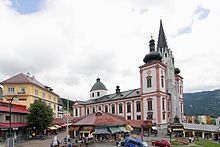 The Basilica of Mariazell is Austria's most popular pilgrimage site
The Basilica of Mariazell is Austria's most popular pilgrimage site View of Salzburg Cathedral
View of Salzburg Cathedral
At the end of the 20th century, about 74% of Austria's population were registered as Roman Catholic,[89] while about 5% considered themselves Protestants.[89] Austrian Christians are obliged to pay a mandatory membership fee (calculated by income—about 1%) to their church; this payment is called "Kirchenbeitrag" ("Ecclesiastical/Church contribution").
Since the second half of the 20th century, the number of adherents and churchgoers has declined. Data for the end of 2005 from the Austrian Roman Catholic church lists 5,662,782 members, or 68.5% of the total Austrian population, and a Sunday church attendance of 753,701 or 9% of the total Austrian population.[90] Data for the end of 2008 published by the Austrian Roman Catholic church shows a further reduction to 5,579,493 members or 66.8% of the total Austrian population, and a Sunday church attendance of 698,527 or 8% of the total Austrian population.[91] The Lutheran church also recorded a loss of 47904 adherents between 2001 and 2008. As of January 2010 the percentage of catholics in Austria declined to 65.1%.[citation needed]
About 12% of the population declared that they have no religion.[89] in 2001. Of the remaining people, around 340,000 are registered as members of various Muslim communities, mainly due to the influx from Turkey, Bosnia-Herzegovina and Kosovo.[89] About 180,000 are members of Orthodox Churches (mostly Serbs), about 21,000 people are active Jehovah's Witnesses[92] and about 8,100 are Jewish.[89]
The Austrian Jewish Community of 1938—Vienna alone counted more than 200,000—was reduced to around 4,500 during the Second World War, with approximately 65,000 Jewish Austrians killed in the Holocaust and 130,000 emigrating.[93] The large majority of the current Jewish population are post-war immigrants, particularly from eastern Europe and central Asia (including Bukharan Jews).[94] Buddhism was legally recognised as a religion in Austria in 1983.[95]
According to the most recent Eurobarometer Poll 2005,[96]
- 54% of Austrian citizens responded that "they believe there is a God".
- 34% answered that "they believe there is some sort of spirit or life force".
- 8% answered that "they do not believe there is any sort of spirit, God, or life force".
While northern and central Germany was the origin of the Reformation, Austria and Bavaria were the heart of the Counter-Reformation in the 16th and 17th centuries, when the absolute monarchy of Habsburg imposed a strict regime to restore Catholicism's power and influence among Austrians.[97][98] The Habsburgs for a long time viewed themselves as the vanguard of Catholicism and all other confessions and religions were repressed.
In 1781, in the era of Austrian enlightenment, Emperor Joseph II issued a Patent of Tolerance for Austria that allowed other confessions a limited freedom of worship. Religious freedom was declared a constitutional right in Cisleithania after the Austro-Hungarian Ausgleich in 1867 thus paying tribute to the fact that the monarchy was home of numerous religions beside Roman Catholicism such as Greek, Serbian, Romanian, Russian, and Bulgarian Orthodox Christians (Austria neighboured the Ottoman Empire for centuries), Calvinist, Lutheran Protestants and Jews. In 1912, after the annexation of Bosnia Hercegovina in 1908, Islam was officially recognised in Austria.
Austria remained largely influenced by Catholicism. After 1918, First Republic Catholic leaders such as Theodor Innitzer and Ignaz Seipel took leading positions within or close to Austria's government and increased their influence during the time of the Austrofascism; Catholicism was treated much like a state religion by Engelbert Dollfuss and Kurt Schuschnigg.[citation needed] Although Catholic (and Protestant) leaders initially welcomed the Germans in 1938 during the Anschluss of Austria into Germany, Austrian Catholicism stopped its support[citation needed]of Nazism later on and many[citation needed] former religious public figures became involved with the resistance during the Third Reich. After the end of World War II in 1945, a stricter secularism was imposed in Austria, and religious influence on politics declined.[citation needed]
Education
Main article: Education in AustriaResponsibility for educational in Austria is entrusted partly to the Austrian states (Bundesländer) and partly to the federal government. School attendance is compulsory for nine years, i.e. usually to the age of fifteen.
Kindergarten education, free in most states, is provided for all children between the ages of three and six years and, whilst optional, is considered a normal part of a child's education, due to its high takeup rate. Maximum class size is around 30, each class normally being cared for by one qualified teacher and one assistant. Standard attendance times are 8 am to 12 pm, with extra afternoon care also frequently provided for a fee.
Primary education, or Volksschule, lasts for four years, starting at age six. Maximum class size is 30, but may be as low as 15. It is generally expected that a class will be taught by one teacher for the entire four years and the stable bond between teacher and pupil is considered important for a child's well-being. The so called "3Rs"(Reading, wRiting and aRithmetic) dominate lesson time, with less time allotted to project work than in the UK. Children work individually and all members of a class follow the same plan of work. There is no streaming. Lessons begin at 8 am and last until noon or 1 pm with hourly five- or ten-minute breaks. Children are given homework daily from the first year. Historically there has been no lunch hour, with children returning home to eat. However, due to a rise in the number of mothers in work, primary schools are increasingly offering pre-lesson and afternoon care.As in Germany, secondary education consists of two main types of schools, attendance at which is based on a pupil's ability as determined by grades from the primary school. The Gymnasium caters for the more able children, in the final year of which the Matura examination is taken, which is a requirement for access to university. The Hauptschule prepares pupils for vocational education but also for various types of further education (Höhere Technische Lehranstalt HTL = institution of higher technical education; HAK = commercial academy; HBLA = institution of higher education for economic business; etc.). Attendance at one of these further education institutes also leads to the Matura. Some schools aim to combine the education available at the Gymnasium and the Hauptschule, and are known as Gesamtschulen. In addition, a recognition of the importance of learning English has led some Gymnasiums to offer a bilingual stream, in which pupils deemed able in languages follow a modified curriculum, a portion of the lesson time being conducted in English.
As at primary school, lessons at Gymnasium begin at 8 am and continue with short intervals until lunchtime or early afternoon, with children returning home to a late lunch. Older pupils often attend further lessons after a break for lunch, generally eaten at school. As at primary level, all pupils follow the same plan of work. Great emphasis is placed on homework and frequent testing. Satisfactory marks in the end-of-the-year report ("Zeugnis") are a prerequisite for moving up ("aufsteigen") to the next class. Pupils who do not meet the required standard re-sit their tests at the end of the summer holidays; those whose marks are still not satisfactory are required to re-sit the year ("sitzenbleiben").
It is not uncommon for a pupil to re-sit more than one year of school. After completing the first two years, pupils choose between one of two strands, known as "Gymnasium" (slightly more emphasis on arts) or "Realgymnasium" (slightly more emphasis on science). Whilst many schools offer both strands, some do not, and as a result, some children move schools for a second time at age 12. At age 14, pupils may choose to remain in one of these two strands, or to change to a vocational course, possibly with a further change of school.
The Austrian university system had been open to any student who passed the Matura examination until recently. A 2006 bill allowed the introduction of entrance exams for studies such as Medicine. In 2001, an obligatory tuition fee ("Studienbeitrag") of €363.36 per term was introduced for all public universities. Since 2008, for all EU students the studies have been free of charge, as long as a certain time-limit is not exceeded (the expected duration of the study plus usually two terms tolerance).[99] When the time-limit is exceeded, the fee of around €363.36 per term is charged. Some further exceptions to the fee apply, e.g. for students with a year's salary of more than about €5000. In all cases, an obligatory fee of €15.50 for the student union and insurance is charged..
Culture
Main article: Culture of AustriaMusic
Main article: Music of Austria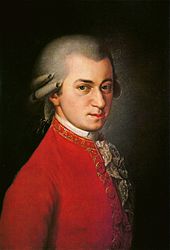 Wolfgang Amadeus Mozart (1756–1791)
Wolfgang Amadeus Mozart (1756–1791)
Austria's past as a European power and its cultural environment have generated a broad contribution to various forms of art, most notably among them music. Austria has been the birthplace of many famous composers such as Joseph Haydn, Michael Haydn, Franz Schubert, Anton Bruckner, Johann Strauss, Sr. and Johann Strauss, Jr. as well as members of the Second Viennese School such as Arnold Schoenberg, Anton Webern and Alban Berg. Wolfgang Amadeus Mozart was born in Salzburg, then an independent Church Principality, though one that was culturally closely connected to Austria, and much of Mozart's career was spent in Vienna.
World famous Vienna State Opera
Vienna has long been especially an important centre of musical innovation. 18th and 19th century composers were drawn to the city due to the patronage of the Habsburgs, and made Vienna the European capital of classical music. During the Baroque period, Slavic and Hungarian folk forms influenced Austrian music.
Vienna's status began its rise as a cultural center in the early 16th century, and was focused around instruments including the lute. Ludwig van Beethoven spent the better part of his life in Vienna. Austria's current national anthem, attributed to Mozart, was chosen after World War II to replace the traditional Austrian anthem by Joseph Haydn.
Austria has also produced one notable jazz musician, keyboardist Josef Zawinul, who helped pioneer electronic influences in jazz as well as being a notable composer in his own right. The pop and rock musician Falco was internationally acclaimed during the 1980s, especially for his song "Rock Me Amadeus" dedicated to Mozart.[100] The drummer Thomas Lang was born in Vienna in 1967 and is now world renowned for his technical ability, having played with artists such as Geri Halliwell and Robbie Williams.
Art and architecture
Further information: List of Austrian artists and architectsAmong Austrian Artists and architects one can find the painters Ferdinand Georg Waldmüller, Rudolf von Alt, Hans Makart, Gustav Klimt, Oskar Kokoschka, Egon Schiele, Carl Moll, and Friedensreich Hundertwasser, the photographers Inge Morath and Ernst Haas, and architects like Johann Bernhard Fischer von Erlach, Otto Wagner, Adolf Loos, and Hans Hollein.
Cinema and theatre
Austrian contributions to the worlds of film and theatre have traditionally been strong. Sascha Kolowrat was an Austrian pioneer of filmmaking. Billy Wilder, Fritz Lang, Josef von Sternberg, and Fred Zinnemann originally came from Austria before establishing themselves as internationally relevant movie makers. Willi Forst, Ernst Marischka, or Franz Antel enriched the popular cinema in German language speaking countries. Michael Haneke became internationally known for his disturbing cinematic studies, before receiving a Golden Globe for his critically acclaimed film The White Ribbon in 2010.
The first Austrian film director receiving an Academy Award was Stefan Ruzowitzky. Many Austrian actors were able to pursue a career, the impact of which was sensed beyond national borders. Among them were Peter Lorre, Helmut Berger, Curd Jürgens, Senta Berger, Oskar Werner, and Klaus Maria Brandauer. Hedy Lamarr and Arnold Schwarzenegger became American as well as international movie stars. Christoph Waltz rose to international fame with his performance in Inglourious Basterds, earning the Palme d'Or for best actor at Cannes in 2009, and the Academy Award for Best Supporting Actor in 2010. Max Reinhardt was a master of spectacular and astute theater productions. Otto Schenk not only excelled as a stage actor, but also as an opera director.
Science and philosophy
Austria was the cradle of numerous scientists with international reputation. Among them are Ludwig Boltzmann, Ernst Mach, Victor Franz Hess and Christian Doppler, prominent scientists in the 19th century. In the 20th century, contributions by Lise Meitner, Erwin Schrödinger and Wolfgang Pauli to nuclear research and quantum mechanics were key to these areas' development during the 1920s and 1930s. A present-day quantum physicist is Anton Zeilinger, noted as the first scientist to demonstrate quantum teleportation.
In addition to physicists, Austria was the birthplace of two of the most noteworthy philosophers of the 20th century, Ludwig Wittgenstein and Karl Popper. In addition to them, biologists Gregor Mendel and Konrad Lorenz as well as mathematician Kurt Gödel and engineers such as Ferdinand Porsche and Siegfried Marcus were Austrians.

These are articles of the
List of Austrians seriesArtists and architects Monarchs Mountaineers Music Politicians Scientists Sports Writers A focus of Austrian science has always been medicine and psychology, starting in medieval times with Paracelsus. Eminent physicians like Theodore Billroth, Clemens von Pirquet, and Anton von Eiselsberg have built upon the achievements of the 19th century Vienna School of Medicine. Austria was home to psychologists Sigmund Freud, Alfred Adler, Paul Watzlawick and Hans Asperger and psychiatrist Viktor Frankl.
The Austrian School of Economics, which is prominent as one of the main competitive directions for economic theory, is related to Austrian economists Joseph Schumpeter, Eugen von Böhm-Bawerk, Ludwig von Mises, and Friedrich Hayek. Other noteworthy Austrian-born émigrés include the management thinker Peter Drucker, sociologist Paul Felix Lazarsfeld scientist Sir Gustav Nossal, sociologist Paul Felix Lazarsfeld and the 38th Governor of California, Arnold Schwarzenegger.
Literature
See also: List of Austrian writers and Austrian literatureComplementing its status as a land of artists and scientists, Austria has always been a country of poets, writers, and novelists. It was the home of novelists Arthur Schnitzler, Stefan Zweig, Thomas Bernhard, Franz Kafka, and Robert Musil, of poets Georg Trakl, Franz Werfel, Franz Grillparzer, Rainer Maria Rilke, Adalbert Stifter, Karl Kraus and children's author Eva Ibbotson.
Famous contemporary playwrights and novelists are Nobel prize winner Elfriede Jelinek, Peter Handke and Daniel Kehlmann.
Food and drink
Main article: Austrian cuisineAustria's cuisine is derived from that of the Austro-Hungarian Empire. Austrian cuisine is mainly the tradition of Royal-Cuisine ("Hofküche") delivered over centuries. It is famous for its well-balanced variations of beef and pork and countless variations of vegetables. There is also the "Mehlspeisen" Bakery, which created particular delicacies such as Sachertorte, "Krapfen" which are doughnuts usually filled with apricot marmalade or custard, and "Strudel" such as "Apfelstrudel" filled with apple, "Topfenstrudel" filled with a type of cheese curd called "topfen", and "Millirahmstrudel" (milk-cream strudel).
In addition to native regional traditions, the cuisine has been influenced by Hungarian, Bohemia Czech, Jewish, Italian, Balkan and French cuisine, from which both dishes and methods of food preparation have often been borrowed. The Austrian cuisine is therefore one of the most multicultural and transcultural in Europe.
Typical Austrian dishes include Wiener Schnitzel, Schweinsbraten, Kaiserschmarren, Knödel, Sachertorte and Tafelspitz. There are also Kärntner Kasnudeln, which are pockets of dough filled with Topfen, potatoes, herbs and peppermint which are boiled and served with a butter sauce. Kasnudeln are traditionally served with a salad. Eierschwammerl dishes are also popular. The "Eierschwammerl", also known as "Pfifferling", are native yellow, tan mushrooms. The candy Pez was invented in Austria, as well as Mannerschnitten. Austria is also famous for its Mozartkugeln and its coffee tradition.
Beer is sold in 0.2 litre (a Pfiff), 0.3 litre (a Seidel, kleines Bier or Glas Bier) and 0.5 litre (a Krügerl or großes Bier or Halbe) measures. At festivals one litre Maß and two litre Doppelmaß in the Bavarian style are also dispensed. The most popular types of beer are lager (known as Märzen in Austria), naturally cloudy Zwicklbier and wheat beer. At holidays like Christmas and Easter bock beer is also available.
The most important wine-producing areas are in Lower Austria, Burgenland, Styria and Vienna. The Grüner Veltliner grape provides some of Austria's most notable white wines and Zweigelt is the most widely planted red wine grape.
In Upper Austria, Lower Austria, Styria and Carinthia, Most, a type of cider or perry is widely produced.
Schnapps of typically up to 60 % alcohol or fruit brandy is drunk, which in Austria is made from a variety of fruits, for example apricots and rowanberries. The produce of small private schnapps distilleries, of which there are around 20,000 in Austria, is known as Selberbrennter or Hausbrand. A very high percentage schnaps is called "Umblachter" and has up to 85% Alcohol.
Sports
Main article: Sport in AustriaDue to the mountainous terrain, alpine skiing is a prominent sport in Austria. Similar sports such as snowboarding or ski-jumping are also widely popular and Austrian athletes such as Annemarie Moser-Pröll, Hermann Maier and Toni Sailer are widely regarded as some of the greatest alpine skiers of all time.
A popular team sport in Austria is football, which is governed by the Austrian Football Association.[101] Austria was among the most successful football playing nations on the European continent placing 4th at the 1934 FIFA World Cup, 3rd at the 1954 FIFA World Cup and 7th at the 1978 FIFA World Cup. However, recently Austrian football has been much less internationally successful in this discipline. It also co-hosted the 2008 UEFA European Football Championship with Switzerland. The national Austrian football league is the Austrian Bundesliga, which includes teams such as record-champions SK Rapid Wien, FK Austria Wien, Red Bull Salzburg and Sturm Graz.
Besides football, Austria also has professional national leagues for most major team sports including the Austrian Hockey League for ice hockey, and the Österreichische Basketball Bundesliga for basketball. Bobsleigh, luge, and skeleton are also popular events with a permanent track located in Igls, which hosted bobsleigh and luge competitions for the 1964 and 1976 Winter Olympics held in Innsbruck. The first Winter Youth Olympics in 2012 will be held in Innsbruck as well. Horseback riding is popular also. The famed Spanish Riding School of Vienna is located in Vienna. [102]
See also
- Outline of Austria
- Index of Austria-related articles
 Austria topics
Austria topicsHistory Geography Goverment Economy Demographics Culture  Geographic locale
Geographic localeStates of Austria  Burgenland ·
Burgenland ·  Carinthia ·
Carinthia ·  Lower Austria ·
Lower Austria ·  Salzburg ·
Salzburg ·  Styria ·
Styria ·  Tyrol ·
Tyrol ·  Upper Austria ·
Upper Austria ·  Vienna ·
Vienna ·  Vorarlberg
VorarlbergInternational membership Member states of the European Union Members of the United Nations Security Council Permanent members 
Term ends 31 December 2011 Term ends 31 December 2012 Council of Europe Institutions - Secretary General
- Committee of Ministers
- Parliamentary Assembly
- Congress
- Court of Human Rights
- Commissioner for Human Rights
- Commission for the Efficiency of Justice
- Commission against Racism and Intolerance
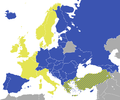
Members Full- Albania
- Andorra
- Armenia
- Austria
- Azerbaijan
- Belgium
- Bosnia and Herzegovina
- Bulgaria
- Croatia
- Cyprus
- Czech Republic
- Denmark
- Estonia
- Finland
- France
- Georgia
- Germany
- Greece
- Hungary
- Iceland
- Ireland
- Italy
- Latvia
- Liechtenstein
- Lithuania
- Luxembourg
- Macedonia1
- Malta
- Moldova
- Monaco
- Montenegro
- Netherlands
- Norway
- Poland
- Portugal
- Romania
- Russia
- San Marino
- Serbia
- Slovakia
- Slovenia
- Spain
- Sweden
- Switzerland
- Turkey
- Ukraine
- United Kingdom
ObserverFormer1 Provisionally referred to by the Council of Europe as "the former Yugoslav Republic of Macedonia"; see Macedonia naming dispute.- Austrian colonial policy
- Federal Criminal Police Office (Austria)
- Index of Austria-related articles
- List of European Research Council grants awarded to Austrian institutions
- List of twin towns and sister cities in Austria
- Telephone numbers in Austria
References
- ^ World Factbook (3 August 2010). "Austria". CIA. https://www.cia.gov/library/publications/the-world-factbook/geos/au.html. Retrieved 14 August 2010.
- ^ a b c "STATISTIK AUSTRIA – Bevölkerungsstand und −veränderung". Statistik.at. 2011-05-19. http://www.statistik.at/web_de/dynamic/statistiken/bevoelkerung/bevoelkerungsstand_und_veraenderung/056447. Retrieved 2011-07-24.
- ^ a b c d e "Austria". International Monetary Fund. http://www.imf.org/external/pubs/ft/weo/2011/01/weodata/weorept.aspx?sy=2008&ey=2011&scsm=1&ssd=1&sort=country&ds=.&br=1&c=122&s=NGDPD%2CNGDPDPC%2CPPPGDP%2CPPPPC%2CLP&grp=0&a=&pr.x=54&pr.y=10. Retrieved 12 April 2011.
- ^ "Distribution of family income – Gini index". The World Factbook. CIA. https://www.cia.gov/library/publications/the-world-factbook/fields/2172.html. Retrieved 1 September 2009.
- ^ "Human Development Report 2011". United Nations. 2011. http://hdr.undp.org/en/media/HDR_2011_EN_Table1.pdf. Retrieved 8 November 2011.
- ^ a b c d e f g "The World Factbook – Austria". Central Intelligence Agency. 14 May 2009. https://www.cia.gov/library/publications/the-world-factbook/geos/au.html. Retrieved 31 May 2009.
- ^ a b c "Die Bevölkerung nach Umgangssprache, Staatsangehörigkeit und Geburtsland". Statistik Austria. http://www.statistik.at/web_de/static/bevoelkerung_2001_nach_umgangssprache_staatsangehoerigkeit_und_geburtsland_022896.pdf. Retrieved 17 November 2010.
- ^ "Austria". Encyclopædia Britannica. Encyclopædia Britannica Online. 31 May 2009. http://www.britannica.com/EBchecked/topic/44183/Austria. Retrieved 31 May 2009.
- ^ "Anschluss". Encyclopædia Britannica. Encyclopædia Britannica Online. 24 September 2009. http://www.britannica.com/EBchecked/topic/26730/. Retrieved 31 May 2009.
- ^ a b Lonnie Johnson 17
- ^ a b "Probezählung 2006 – Bevölkerungszahl 31.10.2006" (in German) (PDF). Statistik Austria. 31 October 2006. http://www.statistik.at/blickgem/pz1/g90001.pdf. Retrieved 27 May 2009.
- ^ Jelavich 267
- ^ "Austria About". OECD. http://www.oecd.org/about/0,3347,en_33873108_33873245_1_1_1_1_1,00.html. Retrieved 20 May 2009.
- ^ "Austria Joins Schengen". Migration News. May 1995. http://migration.ucdavis.edu/mn/more.php?id=643_0_4_0. Retrieved 30 May 2009.
- ^ "University of Klagenfurt". http://wwwg.uni-klu.ac.at/spw/oenf/name2.htm.
- ^ Friedrich Heer: Der Kampf um die österreichische Identität. Böhlau, Wien/Köln/Graz 1981, ISBN 3-205-07155-7.
- ^ "Noricum, römische Provinz". AEIOU. http://www.aeiou.at/aeiou.encyclop.n/n840136.htm;internal&action=_setlanguage.action?LANGUAGE=en. Retrieved 20 May 2009.
- ^ "Rome’s metropolis on the Danube awakens to new life". Archäologischer Park Carnuntum. Archäologische Kulturpark Niederösterreich Betriebsgesellschaft m.b.H.. http://www.carnuntum.co.at/content-en/tales-from-carnuntum. Retrieved 20 February 2010.
- ^ a b Johnson 19
- ^ a b Johnson 20–21
- ^ a b Johnson 21
- ^ Lonnie Johnson 23
- ^ a b Lonnie Johnson 25
- ^ a b Brook-Shepherd 11
- ^ Lonnie Johnson 26
- ^ " The Catholic encyclopedia". Charles George Herbermann (1913). Robert Appleton company.
- ^ "Bentley's miscellany". Charles Dickens, William Harrison Ainsworth, Albert Smith (1853).
- ^ Lonnie Johnson 26–28
- ^ Lonnie Johnson 34
- ^ a b Johnson 36
- ^ Lonnie Johnson 55
- ^ Schulze 233
- ^ Lonnie Johnson 59
- ^ Johnson 52–54
- ^ Grebler, Leo and Winkler, Wilhelm The Cost of the World War to Germany and Austria-Hungary, Yale University Press, 1940.
- ^ Brook-Shepherd 246
- ^ Brook-Shepherd 245
- ^ Brook-Shepherd 257–8
- ^ a b Lonnie Johnson 104
- ^ a b Brook-Shepherd 269–70
- ^ a b Brook-Shepherd 261
- ^ a b Johnson 107
- ^ Brook-Shepherd 283
- ^ Lonnie Johnson 109
- ^ Brook-Shepherd 292
- ^ a b Lonnie Johnson 112–3
- ^ Ian Wallace (1999). "German-speaking exiles in Great Britain". Rodopi. p.81. ISBN 9042004150
- ^ David Art (2006). "The politics of the Nazi past in Germany and Austria". Cambridge University Press. p.43. ISBN 0521856833
- ^ a b Lonnie Johnson 135–6
- ^ Rűdiger Overmans. Deutsche militärische Verluste im Zweiten Weltkrieg. Oldenbourg 2000.
- ^ Anschluss and World War II. Britannica Online Encyclopedia.
- ^ Lonnie Johnson 137
- ^ Manfried Rauchensteiner: Der Sonderfall. Die Besatzungszeit in Österreich 1945 bis 1955 (The Special Case. The Time of Occupation in Austria 1945 to 1955), edited by Heeresgeschichtliches Museum / Militärwissenschaftliches Institut (Museum of Army History / Institute for Military Science), Vienna 1985
- ^ a b Lonnie Johnson 153
- ^ Lonnie Johnson 139
- ^ Lonnie Johnson 165
- ^ Brook-Shepherd 447,449
- ^ Lonnie Johnson 17, 142
- ^ "Bundesministerium für Inneres – Elections Compulsory voting". Bmi.gv.at. Archived from the original on 3 November 2007. http://web.archive.org/web/20071103221527/http://www.bmi.gv.at/wahlen/elections_compulsorey_voting.asp. Retrieved 3 January 2009.
- ^ "Willkommen beim Österreich Konvent". Konvent.gv.at. http://www.konvent.gv.at/. Retrieved 21 November 2008.
- ^ "24 November 2002 General Election Results – Austria Totals". Election Resources on the Internet. 2006. http://electionresources.org/at/nationalrat.php?election=2002. Retrieved 12 June 2009.
- ^ "October 1st, 2006 General Election Results – Austria Totals". Election Resources on the Internet. 2006. http://electionresources.org/at/nationalrat.php?election=2006. Retrieved 12 June 2009.
- ^ "Population statistics". www.statistik.at. http://www.statistik.at/englisch/results/population/population_tab1.shtml. Retrieved 2007-02-24.
- ^ "Alps". Encyclopædia Britannica. Encyclopædia Britannica Online. 11 June 2009. http://www.britannica.com/EBchecked/topic/17356/Alps. Retrieved 12 June 2009.
- ^ "Average Conditions, Vienna, Austria". British Broadcasting Corporation. 2006. http://www.bbc.co.uk/weather/world/city_guides/results.shtml?tt=TT003350. Retrieved 24 May 2009.
- ^ wetterrekorde Central Institute for Meteorology and Geodynamic
- ^ Real GDP Growth – Expenditure Side, provided by the Austrian National Bank (German)
- ^ Mark (2010-11-16). "Mark's Market Analysis". Marksmarketanalysis.com. http://www.marksmarketanalysis.com/2010/11/austria-withholds-greek-bailout-funds.html. Retrieved 2011-07-24.
- ^ "Statistics on Mergers & Acquisitions (M&A) – M&A Courses | Company Valuation Courses | Mergers & Acquisitions Courses". Imaa-institute.org. http://www.imaa-institute.org/statistics-mergers-acquisitions.html#MergersAcquisitions_Austria. Retrieved 2011-07-24.
- ^ "Statistics on Mergers & Acquisitions (M&A) – M&A Courses | Company Valuation Courses | Mergers & Acquisitions Courses". Imaa-institute.org. http://www.imaa-institute.org/statistics-mergers-acquisitions.html#TopMergersAcquisitions_Austria. Retrieved 2011-07-24.
- ^ Ramsey, Jonathon. "Volkswagen takes 49.9 percent stake in Porsche AG". Autoblog.com. http://www.autoblog.com/2009/12/08/volkswagen-takes-49-9-percent-stake-in-porsche-ag/. Retrieved 2011-07-24.
- ^ http://www.erstegroup.com/de/Download?chronicleId=0901481b80005991.pdf
- ^ Lonnie Johnson 168–9
- ^ "Austria Renewable Energy Fact Sheet" (PDF). Europe's Energy Portal. 23 January 2008. http://www.energy.eu/renewables/factsheets/2008_res_sheet_austria_en.pdf. Retrieved 20 May 2009.
- ^ "Renewable energy in Europe". Eurobserv'er. Europe's Energy Portal. 2006. http://www.energy.eu/renewables/eu-charts/chart4.html. Retrieved 20 May 2009.
- ^ 6.5% of the EU population are foreigners and 9.4% are born abroad, Eurostat, Katya VASILEVA, 34/2011.
- ^ "World Directory of Minorities and Indigenous Peoples – Austria: Turks". Minority Rights Group International, World Directory of Minorities and Indigenous Peoples – Austria: Turks, 2008. Online. UNHCR Refworld
- ^ "Beč: Božić na gastarbajterski način | Evropa | Deutsche Welle | 07.01.2010". Dw-world.de. http://www.dw-world.de/dw/article/0,,5096611,00.html?maca=ser-TB_ser_politka1-3157-html-cb. Retrieved 25 April 2010.
- ^ Requirements to become an Austrian citizen, provided by the Viennese state government (German)
- ^ "HKDC Geschichte – Frame". Croates.at. http://www.croates.at/haupt/gesch_fr.htm. Retrieved 21 November 2008.
- ^ de:Windischen-Theorie
- ^ http://www.statistik.at/web_de/static/bevoelkerung_nach_dem_religionsbekenntnis_und_bundeslaendern_1951_bis_2001_022885.pdf
- ^ Medienreferat der Österreichischen Bischofskonferenz / Kathpress.at. "Statistics Catholic Church in Austria 2003–2008". Katholisch.at. http://www.katholisch.at/site/article_blank.siteswift?do=all&c=gotosection&d=site%2Fkirche%2Fkircheinoesterreich%2Fstatistik. Retrieved 25 April 2010.
- ^ "Statistical Data 2001–2008 in German". Evang.at. 31 December 2009. http://www.evang.at/zahlen-und-fakten.html. Retrieved 25 April 2010.[dead link]
- ^ a b Austrian Population 4. Quarter 2009. Retrieved 14 January 2010.
- ^ Medienreferat der Österreichischen Bischofskonferenz / Kathpress.at. "– Das Online-Portal der Katholischen Kirche in Österreich". Katholisch.at. http://www.katholisch.at/content/site/home/article/48339.html. Retrieved 2011-07-24.
- ^ "Bischof Bünker: "Jeder Austritt ist einer zu viel."". Evang.at. 19 January 2010. http://www.evang.at/epd-meldung.html?&tx_ttnews%5Btt_news%5D=2277&tx_ttnews%5BbackPid%5D=68&cHash=4da046c771. Retrieved 25 April 2010.[dead link]
- ^ "Zahlen & Fakten". Evang.at. 2010-12-31. http://www.evang.at/kirche/zahlen-fakten/. Retrieved 2011-07-24.
- ^ a b c d e "Census 2001: Population 2001 according to religious affiliation and nationality" (in German) (PDF). Statistik Austria. http://www.statistik.at/web_de/static/bevoelkerung_2001_nach_religionsbekenntnis_und_staatsangehoerigkeit_022894.pdf. Retrieved 17 December 2007.
- ^ "Kirchliche Statistik der Diozösen Österreichs (Katholiken, Pastoraldaten) für das Jahr 2005". http://www.katholisch.at/site/article_blank.siteswift?so=all&do=all&c=download&d=article%3A107%3A5. Retrieved 21 April 2007.
- ^ "Kirchliche Statistik der Diozösen Österreichs (Katholiken, Pastoraldaten) für das Jahr 2008". http://www.katholisch.at/site/article_blank.siteswift?so=all&do=all&c=download&d=article%3A107%3A9. Retrieved 1 November 2009.
- ^ Statistics: 2010 Report of Jehovah's Witnesses Worldwide.
- ^ Expulsion, Deportation and Murder – History of the Jews in Vienna Vienna Webservice
- ^ Bukharian Jews find homes on Long Island, Bukharian Reviews, 16 September 2004
- ^ "Religionsbekenntnis". AEIOU. http://www.aeiou.at/aeiou.encyclop.r/r480968.htm;internal&action=_setlanguage.action?LANGUAGE=en. Retrieved 22 May 2009.
- ^ "Eurobarometer on Social Values, Science and technology 2005 – page 11" (PDF). http://ec.europa.eu/public_opinion/archives/ebs/ebs_225_report_en.pdf. Retrieved 5 May 2007.
- ^ Lonnie Johnson 28
- ^ Brook-Shepherd 16
- ^ "Studying in Austria: Tuition Fee". Help.gv.at. 1 January 2009. http://www.help.gv.at/Content.Node/148/Seite.1480000.html#tuition. Retrieved 18 June 2009.
- ^ "Falco". VH1. 2007. http://www.vh1.com/artists/az/falco/bio.jhtml. Retrieved 17 June 2009.[dead link]
- ^ "Österreichischer Fußballbund" (in German). ÖFB. 2009. http://www.oefb.at/. Retrieved 17 June 2009.
- ^ "YOG Innsbruck 2012: Relive the announcement". International Olympic Committee. 12 December 2008. http://www.olympic.org/uk/news/olympic_news/full_story_uk.asp?id=2890. Retrieved 24 December 2008.
- Bibliography
- Brook-Shepherd, Gordon (1998). The Austrians: a thousand-year odyssey. New York: Carroll & Graf Publishers, Inc. ISBN 0786705205.
- Jelavich, Barbara (1987). Modern Austria: empire and republic, 1815–1986. Cambridge: Cambridge University Press. ISBN 0-521-31625-1.
- Johnson, Lonnie (1989). Introducing Austria: a short history. Riverside, Calif.: Ariadne Press. ISBN 0929497031.
- Rathkolb, Oliver. The Paradoxical Republic: Austria, 1945–2005 (Berghahn Books; 2010, 301 pages). Translation of 2005 study of paradoxical aspects of Austria's political culture and society.
- Schulze, Hagen (1996). States, nations, and nationalism: from the Middle Ages to the present. Cambridge, Mass.: Blackwell. ISBN 0631209336.
External links
- Austria entry at The World Factbook
- Austria entry at Encyclopædia Britannica
- Austria information from the United States Department of State
- Portals to the World from the United States Library of Congress
- Austria at
- Austria at the Open Directory Project
- Information on Austria Sorted by regions. Choose from 5 languages.
- Government
- Federal Chancellery of Austria official government portal
- AEIOU Austria Albums (in German, English)
- Chief of State and Cabinet Members
- Travel
- Austria.info Official homepage of the Austrian National Tourist Office
- Austria travel guide from Wikitravel
- Austria.mu Homepage of the Austrian Museums
- TourMyCountry.com Website on Austrian culture, cuisine and tourist attractions
- Tourist Informations Service from Austria
- Europe Pictures – Austria
- Miscellaneous
- Austrian Law Information on Austrian Law
- History of Austria: Primary Documents from EuroDocs
- Guide to materials pertaining to Austria, Dwight D. Eisenhower Presidential Library
Categories:- Austria
- Alpine countries
- Erasmus Prize winners
- European countries
- Federal countries
- German-speaking countries
- Landlocked countries
- Liberal democracies
- Member states of the Council of Europe
- Member states of the European Union
- Member states of the Union for the Mediterranean
- Member states of the United Nations
- Republics
- States and territories established in 1955
- Nuclear-free zones
Wikimedia Foundation. 2010.

![Location of Austria (dark green)– in Europe (green & dark grey)– in the European Union (green) — [Legend]](/pictures/enwiki/50/250px-EU-Austria.svg.png)
